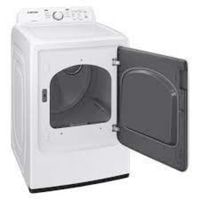Samsung dryer overheating. If your Samsung dryer is overheating, this may be due to the heating element warming the air before it enters the dryer drum.
As an owner of a Samsung dryer, you want to make sure that your exhaust vent is unobstructed to remain safe and protected from damages and fires!
A restriction in your exhaust vent will reduce airflow in your dryer which will result in higher temperatures inside the drum itself. The rising temperature inside your machine will turn off the high limit thermostat.
Samsung dryer overheating
Here we will discuss some common issues and solutions for Samsung dryer overheating.
Defective Cycling Thermostat
A faulty cycling thermostat can be the reason your clothes dryer is not drying your clothes.
In a cycling thermostat, the heat is cycled on and off to maintain a constant temperature. When the heating element becomes too hot, it will need to be turned off manually.
The thermostat was designed with a safety feature that turns off the power if it happens to overheat for an extended period of time. If this problem occurs, check the more commonly defective parts first.
The cycling thermostat has continuity when electricity flows freely in both directions from one terminal to another. There should be no interruption in current flow.
To test, use a multimeter and make sure there is no resistance in either direction, if there isn’t replace the cycling thermostat as it could be shorted out due to improper installation or condensation buildup.
Problem with Heating Element
The element in the dryer warms up the air before it enters the drum. If this element is partially shorted out, it may produce too much heat and possibly lead to a fire risk and costly maintenance costs.
To determine if this heating element is faulty, one must ensure that each terminal’s connection to the case is intact with a multimeter. If there isn’t continuity, one must replace this heating element immediately!
Felt Seal is damage
Most dryers have a felt seal that protects the heat produced. If the seal is worn or missing, the length it travels will be cut down, which impedes its ability to draw heat from the drum through the other side.
Check the seal to ensure that it creates a reliable and sealed enclosure around the drum for safe heat dispersion. Rarely does this cause problem, though take time to verify all more commonly malfunctioning parts such as bearings and axles before replacing felt seals.
Air Flow issue
If your dryer’s vent is clogged or partially clogged, it can severely reduce airflow and greatly increase drying times.
To ensure proper dryer performance, you should clean your dryer’s bottom venting system once per year to maintain a strong airflow, removing any lint buildup as a result of normal use and preventing any problems from developing in the future.
Defective Blower Wheel
The blower wheel works with the motor to push air through the tumbler. Small articles of clothing, socks, and lint can get stuck inside the blower wheel. Also, the blower wheel sleeve can wear out, causing the blower wheel to wobble on the motor shaft.
If there is an obstruction or a defect on your unit’s blower wheel, it may lead to extensive damage (also known as a “blowing fire” incident).
To determine if you have a functioning blower wheel, assess it for obstructions and rotate it manually by hand. If it is loose or turns unevenly, you will need to replace this piece immediately.
Related Guides
